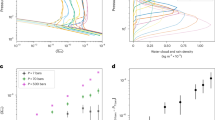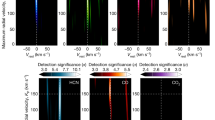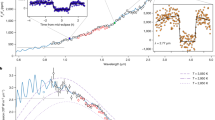Abstract
Phosphine (PH3) has recently been identified as a constituent of the atmospheres of Jupiter and Saturn1–3. It is probably formed in the hot depths of the atmospheres of these planets and is carried to the upper levels by atmospheric turbulence. The red colorations in the atmosphere and Great Red Spot of Jupiter may be due to the photolysis of the PH3 in the upper atmosphere to red phosphorus (P4) (ref. 4). We initiated an investigation of PH3 photolysis because of its potential significance in the atmospheric chemistry of Jupiter4–6. We report here that P2H4 is the initial product of PH3 photolysis and that it is the principal intermediate in the formation of red phosphorus. These findings require substantial revision of the previously accepted mechanism for PH3 photolysis6–8.
This is a preview of subscription content, access via your institution
Access options
Subscribe to this journal
Receive 51 print issues and online access
$199.00 per year
only $3.90 per issue
Buy this article
- Purchase on SpringerLink
- Instant access to full article PDF
Prices may be subject to local taxes which are calculated during checkout
Similar content being viewed by others
References
Ridgway, S. T., Wallace, L. & Smith, G. R. Astrophys. J. 207, 1002–1006 (1976).
Ridgway, S. T., Larson, H. P. & Fink, U. Jupiter (ed. Gehrels, T.) 384–417 (University of Arizona Press, Tucson, 1976).
Bregman, J. D., Lester, D. F. & Rank, D. M. Astrophys. J. 202, L55–L56 (1975).
Prinn, R. G. & Lewis, J. S. Science 190, 274–276 (1975).
Strobel, D. F. Astrophys. J. 214, L97–L99 (1977).
Ruiz, H. G. V. & Rowland, F. S. Geophys. Res. Lett. 5, 407–410 (1978).
Melville, H. W. Proc. R. Soc. A138 374–394 (1932); 139, 541–557 (1933).
Norrish, R. G. & Oldershaw, G. A. Proc. R. Soc. A262, 1–9 (1961).
Harteck, P., Reeves, R. R. Jr. & Thompson, B. A. Z. Natwforsch. 19 A, 2 (1964).
Nixon, E. R. J. phys. Chem. 60, 1054–1059 (1956).
Evers, E. C. & Street, E. H. Jr., J. Am. chem. Soc. 78, 5726–5730 (1956).
Groth, W. E., Schurath, W. & Schindler, R. N. J. phys. Chem. 72, 3914–3920 (1968).
Halmann, M. (ed.) Analytical Chemistry of Phosphorous Compounds, 30 (Wiley, New York, 1972).
Noyes, W. A. Jr & Leighton, P. A. The Photochemistry of Gases 374 (Dover, New York, 1966).
Lee, J. H., Michael, J. V., Payne, W. A., Whytock, D. A., Stief, L. J. J. chem. Phys. 65, 3280–3283 (1976).
Peterson, D. B. The Radiation Chemistry of Ammonia (NSRDS-NBS44, U. S. Department of Commerce, National Bureau of Standards, 1964).
Stief, L. J. & Payne, W. A. J. chem. Phys. 64, 4892–4896 (1976).
DiStefano, G., Lenzi, M., Margani, A., Mele, A. & Xuan, C. N. J. Photochem. 7, 335–344 (1977).
Author information
Authors and Affiliations
Rights and permissions
About this article
Cite this article
Ferris, J., Benson, R. Diphosphine is an intermediate in the photolysis of phosphine to phosphorus and hydrogen. Nature 285, 156–157 (1980). https://doi.org/10.1038/285156a0
Received:
Accepted:
Issue date:
DOI: https://doi.org/10.1038/285156a0
This article is cited by
-
Photochemistry of NH3, CH4 and PH3. Possible applications to the Jovian planets
Origins of Life (1982)



